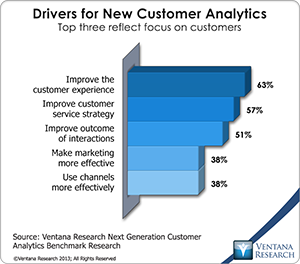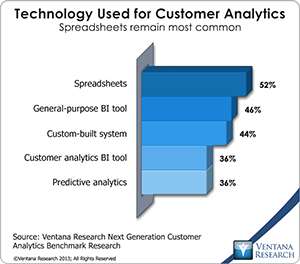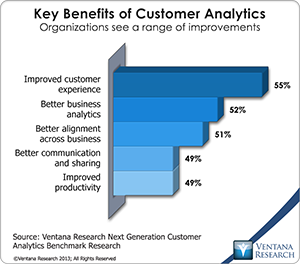Recently my colleague Tony Cosentino wrote an analyst perspective asserting that big data analytics will displace net promoter score (NPS) for more effectively measuring the entire customer experience. This prompted a response from Maxie Schmidt-Subramanian, asserting that big data and NPS aren’t the only ways to measure customer experience success. The main point of Tony’s piece, as I interpret it, is that NPS is just a number, but big data analytics can reveal much more about customer behavior and intentions, and it can link these to business outcomes. On the other hand Maxie argues that whether or not companies use NPS, when it comes to measuring the customer experience, they rely too much on surveys and no one metric does the entire job. While to a large extent I agree with both arguments, from a business perspective I don’t think either addresses three very important questions. The first is what actually is the customer experience? Second, how should it be measured? And third, what is the best use of big data in relation to customer experience?
I recently wrote about how to deliver EPIC customer experiences. This acronym includes four elements that go a long way toward defining a superior customer experience: It must be Easy (in availability of channels at times of the customer’s choice, and in use of technology), Personalized, In context (reflecting previous interactions) and above all Consistent (presenting the same timely information regardless of channel, whether assisted or self-service). That said, I believe that what is most important, for both customer and company, is the outcome of the interaction. Was the problem resolved to the customer’s satisfaction? Did the caller find and purchase the products or services being sought? Of course there are other considerations such as the cost of the interaction and the customer’s subsequent value to the organization.
outcome of the interaction. Was the problem resolved to the customer’s satisfaction? Did the caller find and purchase the products or services being sought? Of course there are other considerations such as the cost of the interaction and the customer’s subsequent value to the organization.
Regarding the second question, various metrics are useful to assess different outcomes and the true customer experience. Our benchmark research into next-generation customer analytics illustrates this point, showing that companies use on average 11 metrics to assess customer-related activities: Among the most widely used, three are financial (adherence to budget, customer service costs and customer profitability), five are process-oriented (including call outcomes, performance vs. service level agreement and agent quality scores), and three are customer-specific (customer satisfaction, cost to serve and lifetime value). Perhaps in contrast to popular opinion, NPS ranked only fifth among customer-specific metrics. Our research also finds that improving customer experience is a top priority and driver for improving in 63 percent of organizations. Overall the results strongly suggest that most companies are undecided on how to measure the customer experience, but they seem to agree one metric isn’t enough.
That brings us to big data, and to analytics applied to it. Companies, especially large ones serving consumers, have always had a lot of customer data, including from CRM, ERP, billing and other business applications to interaction-related data in call recordings, email letters and other forms. Recently the volume and variety both have increased significantly because companies often have web, email, IVR recordings, text records, social media surveys, Web scripts, chat scripts, instant  messages, social media posts, video recordings and output from mobile apps. But most companies can’t do much with all this data. Our benchmark research into next-generation customer analytics finds that the most common tools used to produce metrics, reports and analysis are spreadsheets and general-purpose business intelligence tools. While each of these has its uses, both require considerable manual effort, and neither can process unstructured data (such as voice, text and events) or expose insights from the content; they can’t, for example, determine customer satisfaction because of what was said. Nor do they make it easy to gather data from multiple sources; for example, before purchasing a new product, a customer might have had multiple visits to the company website, chat sessions with contact center agents, phone calls with people in several business groups, filled out feedback surveys and posted a comment on social media complaining how difficult the process had been. To achieve all three, systems must be able to link data from multiple sources and apply data, speech and text analytics; these are common capabilities of several big data analytics products. The foundation of big data is important as it was found to be the second most important technology category for customer analytics in 60 percent of companies after collaboration and 44 percent of companies are using it today according to our next generation customer analytics research. My main point is that big data is ultimately not just about volumes and speed of change but about understanding the data companies have and putting the information to use to deliver the desired outcomes.
messages, social media posts, video recordings and output from mobile apps. But most companies can’t do much with all this data. Our benchmark research into next-generation customer analytics finds that the most common tools used to produce metrics, reports and analysis are spreadsheets and general-purpose business intelligence tools. While each of these has its uses, both require considerable manual effort, and neither can process unstructured data (such as voice, text and events) or expose insights from the content; they can’t, for example, determine customer satisfaction because of what was said. Nor do they make it easy to gather data from multiple sources; for example, before purchasing a new product, a customer might have had multiple visits to the company website, chat sessions with contact center agents, phone calls with people in several business groups, filled out feedback surveys and posted a comment on social media complaining how difficult the process had been. To achieve all three, systems must be able to link data from multiple sources and apply data, speech and text analytics; these are common capabilities of several big data analytics products. The foundation of big data is important as it was found to be the second most important technology category for customer analytics in 60 percent of companies after collaboration and 44 percent of companies are using it today according to our next generation customer analytics research. My main point is that big data is ultimately not just about volumes and speed of change but about understanding the data companies have and putting the information to use to deliver the desired outcomes.
My most recent research studies show that the majority of companies run their communication channels independently of each other and business groups chase their own goals so that there is little collaboration between them; these disconnections are among the reasons most customer experiences are far from EPIC. To improve we recommend that companies take the following steps. First and foremost in a multichannel world is understanding actual customer journeys, which I have written about. These journeys cross channels and business groups, extend throughout the customer life cycle and differ for individual products and services. Big data is needed to ingest and process the great volumes and many types of data involved, including all the data associated with a named customer, and analytics is necessary to produce analysis and metrics. These tools can help companies understand the outcomes of all those journeys and identify ways to improve them. In addition companies can benefit from using predictive analytics to examine past journeys and use them and scenarios to predict likely outcomes of current or future journeys; for example, if customers that go down a certain path often stop being customers, the company should find ways to influence them to take more productive paths.
Secondly, companies should rethink the metrics they use. Our customer analytics research finds that companies often claim to be trying to improve one aspect of service – for example, customer satisfaction – but measure another – say, average handling time. Once again metrics should align with desired outcomes: If cost control is important, measuring handling times makes sense as these have a direct correlation of costs, but if customer satisfaction is most important find metrics such as customer satisfaction measured over time and customer  value that relate to it. Our next generation customer analytics research finds that the largest benefit from analytics is to improve the customer experience according to over half (55%) of organizations.
value that relate to it. Our next generation customer analytics research finds that the largest benefit from analytics is to improve the customer experience according to over half (55%) of organizations.
Thus it is clear that companies need a balanced set of metrics that are directly related to what they are trying to achieve and are shared across the organization. The last point is very important and ties to Maxie’s point that “humans need a concept to rally around.” For example, I know of a company in which everyone’s compensation depended to some extent on customer satisfaction scores. Leaving aside whether they were measuring this objectively, it stopped employees from doing things that might result in bad customer experiences and thus lower customer satisfaction scores; one obvious example is selling customers the wrong product. One metric I endorse is customer lifetime value. This is an outcome metric that addresses both sides of the cost and revenue equation, is a strong indicator of customer loyalty and reflects both customer experience and employee performance.
To build on Tony’s and Maxie’s analyses let me finish with four observations:
- The right analytics, whether called big data or not, can reveal more about the customer experience than any metric. It can also precisely calculate metrics such as lifetime value that require multiple data sources.
- It is likely that companies will go on using surveys, albeit using more channels, as a means of gaining feedback from customers. However, companies can gain more value by using speech and text analytics to gain broader insights that reflect customers’ feelings and predict their likely actions.
- Companies should adopt real-time or near-real-time customer journey maps, showing outcomes and including predictive capabilities, to help manage and improve the customer experience.
- There is no golden customer experience metric; customer lifetime value is probably the closest. So it is necessary to use multiple metrics, which companies should share more and use to drive action as there is no point in metrics for metrics’ sake.
Customer experience has become a key differentiator for many companies. However getting it right is not easy. So I recommend that organizations take into account my observations as they strive to create more loyal and thus more valuable customers.
Regards,
Richard J. Snow
VP & Research Director












